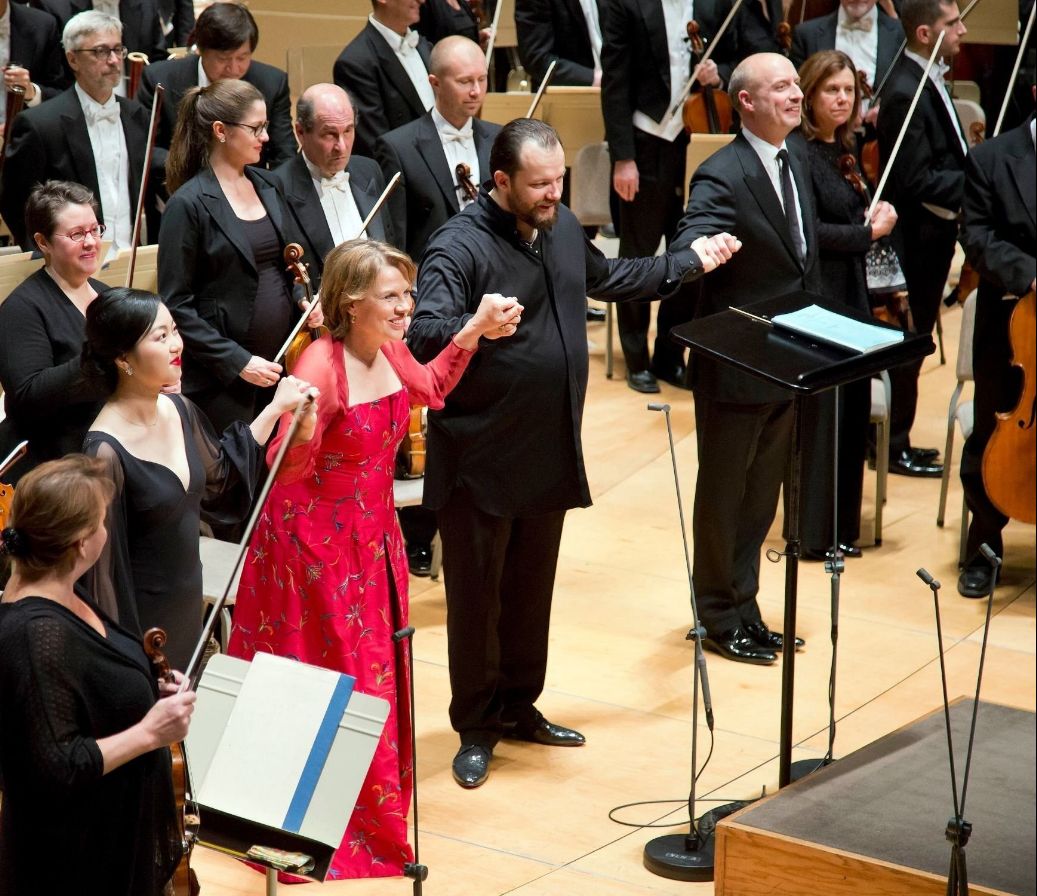BSO Delivers a Triumphant Finale to Mahler's Second Symphony

Ying Fang, Bernarda Fink, Andris Nelsons, and James Burton bow following the BSO's performance of Mahler 2 on October 25, 2018. Photo credit: Winslow Townson.
Mahler once said of his Second Symphony that it "can no more be explained than the world itself." Tackling it means finding some way to balance a large mixed choir, two soloists, an off-stage brass group, and an oversized orchestra. For any orchestra, performing Mahler 2 is a monumental task -- and the Boston Symphony Orchestra did it four times this week.
For most ensembles, simply putting on the performance is a success. Frankly, it's hard not to enjoy Mahler 2; the sheer beauty and grandiosity of the composition provide enough reason to forgive a mediocre interpretation. Sitting in the concert hall on Saturday night, you could hear the hum of anticipation pulsing through the audience. They knew that what they were about to hear promised to be special.
Unfortunately, though the BSO did eventually deliver on that promise, it was not until halfway through the third movement of the symphony.
The night began with a short choral piece by Latvian composer Maija Einfelde, "Lux aeterna," chosen to mark the centennial of Latvian independence. The Tanglewood Festival Chorus gave a haunting performance, weaving a blanket of sound that was occasionally punctuated by the sparkling sound of crotales. As an appetizer before the central work in the program, the piece could not have been better chosen; by the time the applause faded, there was an electric tension in the audience as they waited for Nelsons to enter the stage.
The first movement of the Mahler is a storm of shifting characters, alternating between suspense and sweetness, drama and tranquility. Although Nelsons masterfully navigated the differing tones and textures, the orchestra failed at times to produce a cohesive idea, partly due to some strange tempo choices. Transitions felt oddly disjoint. It seemed almost as if the orchestra had been jaded by the first two performances of the symphony on Thursday and Friday, and the novelty of it all had slipped away. Still, the BSO’s professionalism carried it through the movement.
The program notes indicated that Mahler originally intended there to be a five-minute pause in between the first and second movements, both for the logistical purpose of bringing the soloists onstage and for cleansing the audience’s palate, since, in Mahler’s words, “the second movement has the effect after the first, not of contrast, but as a mere irrelevance.” The length of the pause may seem trivial, but Nelsons’s decision to respect it showed a respect for the composer’s intention and an understanding of the audience’s experience. However, the second movement felt somewhat lethargic, and lacked the impulse necessary to buoy up the gentle dance.
It was not until the iconic death shriek in the third movement that the orchestra began to pick up momentum, which it did not lose for the rest of the night. Indeed, the final two movements were stunning. Nelsons’s coordination with the off-stage musicians was impeccable, and the Urlicht, performed by Bernarda Fink, was ethereal. But it was clear that Chinese soprano Ying Fang was the star of the night. Her sound was full-bodied and rich, possessing a weight and a gravity that is seldom found in the soprano range, without sacrificing any of its warmth. When the orchestra at last reached the end of the fifth movement, it was a triumph of musicianship. The first bravo came before Nelsons lowered his baton.
Joyce Lu is a radio host for WHRB Classical. Tune in to WHRB for classical music anytime Monday through Friday from 1 to 10pm, Saturday from 1 to 9pm, and Sunday from 2pm to midnight.